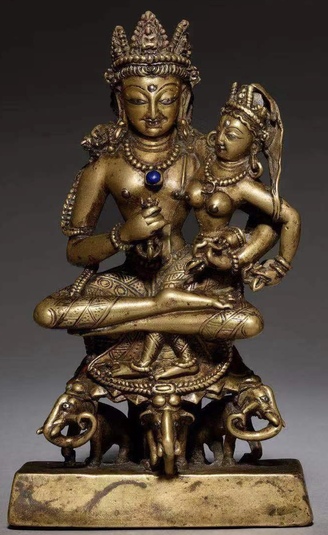
Item: Vajrasattva (Buddhist Deity)
| Origin Location | Northern India |
|---|---|
| Date Range | 1000 - 1099 |
| Lineages | Buddhist |
| Material | Metal, Copper Inlay, Silver Inlay, Precious Stone, Silver Eyes, Stone Inset: Lapis Lazuli |
| Collection | Private |
Classification: Deity
Vajrasattva, Vajrapani or Akshobhya Buddha.
The identity of this figure is not fully known. In appearance the central male figure is peaceful with one face and two arms. The right hand holds a vajra scepter at the heart and the left a vajra handled bell at the side. Adorned with a crown and jewellery he sits in a relaxed posture, with the right leg over the left, above an elephant supported throne. Seated at the proper left side of the male figure is a consort in similar appearance, also holding a vajra and bell. She sits with the legs extended seated atop the left thigh of the male consort.
Video: Vajrapani & Vajrasattva Confusions
Both figures are adorned with a crown, earrings, short necklace armlets, bracelets, and a lower garment. The hair is long with some piled on the top of the head. The crown has three points and at the center leaf of the male deity is a small figure of what appears to be Akshobhya Buddha. A large blue lapis lazuli stone adorns the central figure's necklace. The eyes, lips and central dot on the forehead have silver and copper inlay. The unusual base is rectangular in shape and supports three elephants with long trunks and a small lotus seat above.
The two Buddhist figures of Vajrasattva and Vajrapani in peaceful demeanor are commonly mistaken one for the other as their appearance can be identical especially with sculptural objects. There can also be a confusion with some Tantric forms of Akshobhya where he also can appear in an identical manner to Vajrasattva with the consort seated on the left lap.
With painted images the colour of the two figures can be different and that can indicate a more precise identification, but not in all cases. Akshobhya typically is blue. Vajrasattva is white. Vajrapani can be blue, green or white. However, with sculpture there is no colour and other characteristics must be used to come to a clear determination of identity, whenever possible.
When Akshobhya Buddha appears in Sambhogakaya appearance it is generally as part of a set of sculpture or paintings, depicting each of the Five Symbolic Buddhas and representing the directional quadrants of a mandala. They each would appear identical in posture, with a consort, and each with their own hand attributes and specific body colour.
The depiction of a buddha figure in the crown does present some problems for a Vajrasattva identification of the sculpture. Vajrasattva in Tantric Buddhist hierarchy is above the Five Symbolic Buddhas and is referred to as the leader, or owner, of one hundred buddha families, not just the five commonly known families. If the buddha in the crown is Akshobhya then that would suggest that the sculptural figure is likely to be Vajrapani. At this time it is not determined.
Knowing the function and intention for the creation of the sculpture will partially depend on a correct identification. However, the small size suggests that it was for personal use rather than for display or for ritual function in a large temple space. Whether it belonged to a set or was a single creation is also not known. For an object of this age and size it is in remarkably good condition. There are signs of age with some abrasions, dents and pitting of the metal. The vajra in the right hand of the central figure is missing the extended prongs of the top portion, but over all the sculpture is surprisingly complete for such a delicate and beautiful object. (See HAR #35939).
Jeff Watt 12-2018
Exhibition: RMA Masterworks, January 28th, 2021
Thematic Sets
Collection of Zhiguan Museum of Fine Art
Subject: Confused Iconography (Akshobhya, Vajrasattva, Vajrapani)
Subject: Couples in Himalayan Style Art
Buddhist Deity: Vajrasattva Main Page
Collection: Christies, Sculpture (March, 2000; NY)
Buddhist Deity: Vajrasattva Masterworks (Sculpture)
Collection of Zhiguan Museum of Fine Art (RMA 2019)
Collection of Zhiguan (Sculpture)
Subject: Confusions (Vajrasattva & Vajrapani)
